Lomas de Arena Municipal Park
By
Bennett Hennessey
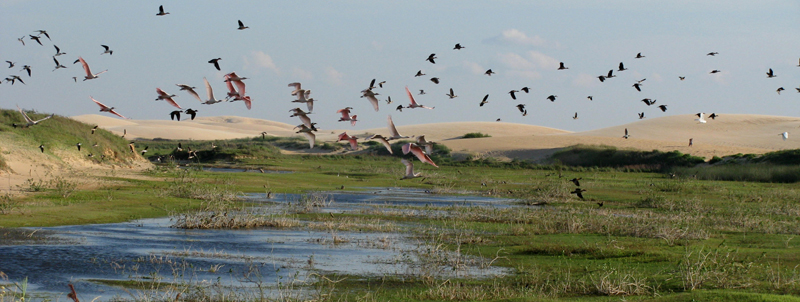
If you are using this free service, please support Bolivian Bird
conservation by designating
a tax deductible donation to Armonia through ABC
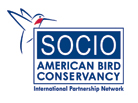 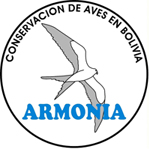
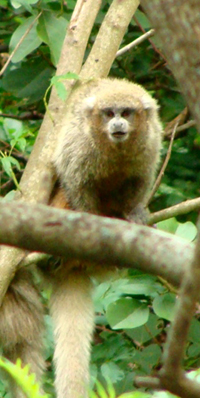 Lomas de Arena was initially preserved because of a small lake between
sand dunes that can give the impression of having a beach. Several
types of habitats are preserved in the area: savannahs, dry forest, marshes and large water bodies. The area is also a stop over
and wintering ground for many Austral and Boreal migrants. Over 240
birds have been recorded in the park but it is believed only 70 are actual
residents (Bird List for Lomas de Arena). The usual daily list stands at 60-80 species. The bird
community is in constant flux, with many crazy single day records of hundreds
of Austral migrant birds just passing through on their way to or from Argentina. Moreover, in Bolivia
's
summer, Eastern Kingbirds and Barn Swallows can be the most abundant
birds. The area has many easily seen desired birds such as Comb Duck,
Brazilian Duck, Burrowing Owl, White-eared Puffbird, White Woodpecker,
Chalk-browed Mockingbird, and Chotoy Spinetail. The area also harbours
some rarities like Toco Toucan, and Red-legged Seriema. Lomas de Arena was initially preserved because of a small lake between
sand dunes that can give the impression of having a beach. Several
types of habitats are preserved in the area: savannahs, dry forest, marshes and large water bodies. The area is also a stop over
and wintering ground for many Austral and Boreal migrants. Over 240
birds have been recorded in the park but it is believed only 70 are actual
residents (Bird List for Lomas de Arena). The usual daily list stands at 60-80 species. The bird
community is in constant flux, with many crazy single day records of hundreds
of Austral migrant birds just passing through on their way to or from Argentina. Moreover, in Bolivia
's
summer, Eastern Kingbirds and Barn Swallows can be the most abundant
birds. The area has many easily seen desired birds such as Comb Duck,
Brazilian Duck, Burrowing Owl, White-eared Puffbird, White Woodpecker,
Chalk-browed Mockingbird, and Chotoy Spinetail. The area also harbours
some rarities like Toco Toucan, and Red-legged Seriema.
It is
advisable to visit the area with a rental 4x4 vehicle. In the dry season (May to Sept) you can visit the first ¾ of the park road in a taxi or
other two wheel drive vehicle. The last ~3 km of the road going
to the lake passes a loose sand area that is only advisable for 4x4 vehicles
in all weather conditions.
With the possibilities of strong winds and the openness of
Lomas de Arena, we recommend starting birding at first light. The park
opens at 7 am, but the park guard sleeps in the gate 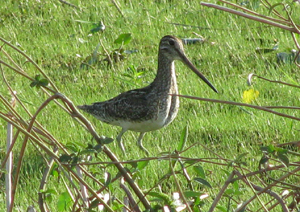 office and in the past
he has had no problem opening the gate earlier. All the birding in the park can be based
around the first single entrance road, which travels and ends at the large
lake beside a large sand dune. The area is scattered with barbed wire
to fence in cattle. Most of the park area remains private land. The wire is
meant for cows and does not mean that people cannot enter- though if there
are ranchers there, it is always best to ask permission as a gesture of
respect. The best method is to find a large gap between two poles, and
push down with your foot on one wire while lifting the above wire.
Commonly seen birds along the entrance road are Picazuro Pigeon,
Peach-fronted Parakeet, Blue-winged Parrolet, Yellow-chevroned Parakeet,
Dark-billed Cuckoo, Striped Cuckoo, Spot-backed Puffbird, Chotoy Spinetail,
Rufous-fronted Thornbird, Barred Antshrike,
Yellow-bellied Elaenia, Tawny-crowned Pygmy-Tyrant, Fork-tailed Flycatcher,
Fawn-breasted Wren, Rufous-browed Peppershrike, and Epaulet Oriole. office and in the past
he has had no problem opening the gate earlier. All the birding in the park can be based
around the first single entrance road, which travels and ends at the large
lake beside a large sand dune. The area is scattered with barbed wire
to fence in cattle. Most of the park area remains private land. The wire is
meant for cows and does not mean that people cannot enter- though if there
are ranchers there, it is always best to ask permission as a gesture of
respect. The best method is to find a large gap between two poles, and
push down with your foot on one wire while lifting the above wire.
Commonly seen birds along the entrance road are Picazuro Pigeon,
Peach-fronted Parakeet, Blue-winged Parrolet, Yellow-chevroned Parakeet,
Dark-billed Cuckoo, Striped Cuckoo, Spot-backed Puffbird, Chotoy Spinetail,
Rufous-fronted Thornbird, Barred Antshrike,
Yellow-bellied Elaenia, Tawny-crowned Pygmy-Tyrant, Fork-tailed Flycatcher,
Fawn-breasted Wren, Rufous-browed Peppershrike, and Epaulet Oriole.
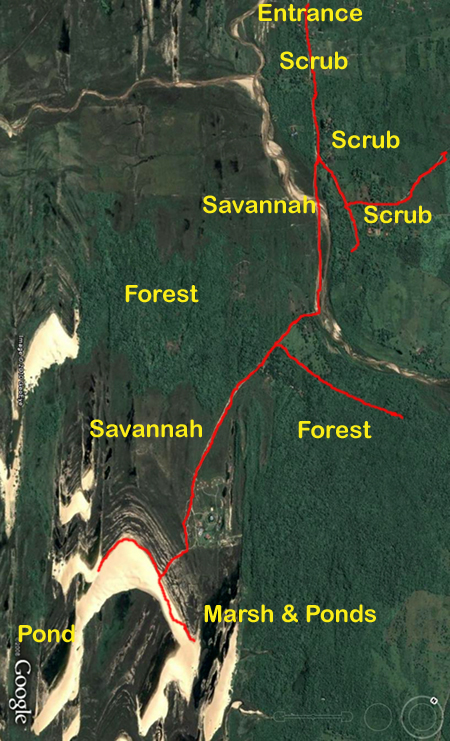 Follow the road entering into the park, paying attention to
variations in habitat. You will first travel through scrub, which is good for early morning birding. The road will eventually come
to a fork. To the left, or East (travelling South), are the fields of Simon I. Patino Centre which is a mix of pasture land and forest fragments. Taking the right fork, it will bring you down to a grassy river basin and a small river crossing. Look out here for shorebirds, and seedeaters
and a Whistling Heron that is often around the opposite bank. Follow the road entering into the park, paying attention to
variations in habitat. You will first travel through scrub, which is good for early morning birding. The road will eventually come
to a fork. To the left, or East (travelling South), are the fields of Simon I. Patino Centre which is a mix of pasture land and forest fragments. Taking the right fork, it will bring you down to a grassy river basin and a small river crossing. Look out here for shorebirds, and seedeaters
and a Whistling Heron that is often around the opposite bank.
Continue birding the road across the small river where it
rises again out of the basin and through a small dry forest area. On the right there was an artificial lake
past the cattle fence which flooded its main gates. There is a barbed wire entrance door to
this area. Possibly one could see in the area Rufescent Tiger-Heron, Cocoi
Heron, Roseate Spoonbill, Brazilian Duck, Rusty-margined Flycatcher, and
Social Flycatcher.
Continue following the road where you will eventually come
to a large forest on the left (East) side while traveling to the lake. There is a small simple road that travels into a decent forest just after a cleared field (see map). From here on, heading to the ponds, the road becomes very sandy and is only recommended for 4x4
vehicles. Taxis can wait here while
you birdwatch. Continue along the road
as the forest ends to the right. Cross
over the fence and bird the forest border savannah. This is where the Red-legged Seriema is
commonly seen. Walk
further into the grassland and walk randomly through the different types of
grasses and hills and boggy areas.
Birds seen in this area are Red-winged Tinamou, White-bellied Nothura,
Buff-necked Ibis, White-tailed Hawk, Southern Caracara, Burrowing Owl,
White-eared Puffbird, White-woodpecker (Austral Migrant), Campo Flicker,
Pale-breasted Spinetail, Hudson's Black-Tyrant (Austral Migrant), Spectacled
Tyrant, Black-backed Water-Tyrant, Yellowish Pipit, Wedge-tailed Grass-Finch,
and the rare Black-throated Saltator.
Further on the road is the Hotal Sol & Arena. Over the vegetated small sand dunes east of the hotel (just behind the dining area) is a large area of closed dry and mixed forest that is well worth a visit. The land is private and used for cattle pasture. There is no official trail system, but there is a well used cattle trail that travels over the vegetated sand dunes and into the forest, from there travelling north and south. In the closed forest
area there is Ferruginous Pygmy-Owl, Blue-crowned Trogon,
Blue-crowned Motmot, Chestnut-eared Aracari, Toco Toucan, Narrow-billed
Woodcreeper, Buff-breasted Woodcreeper, Great Antshrike, Steaked Flycatcher, Crowned Slaty-Flycatcher,
Moustached Wren, Plush-crested Jay, Grayish Saltator, and Orange-backed
Troupial.
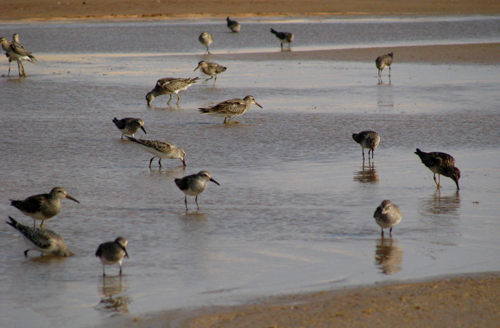 During the heat of the day, visit the large lake at the end
of the road where you might be able to see White-faced Whistling-Duck,
Black-bellied Whistling-Duck Comb Duck, and Black-necked Stilt. During the heat of the day, visit the large lake at the end
of the road where you might be able to see White-faced Whistling-Duck,
Black-bellied Whistling-Duck Comb Duck, and Black-necked Stilt.
Logistics: WARNING: The roads into Lomas de Arena are not paved and there are areas of deep sand, ponds and small rivers to be crossed. A 4x4 is highly recommended- without one, you will not be able to visit the entire park. Bird Bolivia can provide a 4x4 vehicle and driver for 6 passengers for 100 USD a day.
Lomas de Arena is located south of the city off Avenida Santos Demont.
You need to take Avenida Santos Dumont to the very end, almost reaching the
Palmasola refinery. Just before the refinery, you will see another paved road
that turns left (east) from Avenida Santos Dumont. There should also be signs
for the park Lomas de Arene, and to the Santa Cruz Armonia office.
Follow the paved road over the railway tracks, and past the small dirt road
on the right. Take the second right larger dirt road (there is a sign for the
park and Armonia at this corner as well). Follow this road straight for about
.5 km.
You will travel over a small bridge and then come to an open area. On the
left there is a sign for Armonia's office- which is only
100 m further straight.
Please feel free to stop by, use their library, and buy a T-shirt to support a project. You can support their actions by becoming an Armonia
member. Turn right at this intersection following the larger dirt road- which
will lead to the park gates after a few hard turns (~2 km).
Within the park is the hotel Sol & Arena, which offers good accomodation in the middle of a natural setting, 30 minutes from downtown Santa Cruz. From the hotel most good birding areas are accessible by foot. Contact Bird Bolivia to make a reservation, or to order lunch at the hotel during a day visit.
GPS reading at Park
entrance: S 17°53.360 W 063°10.805
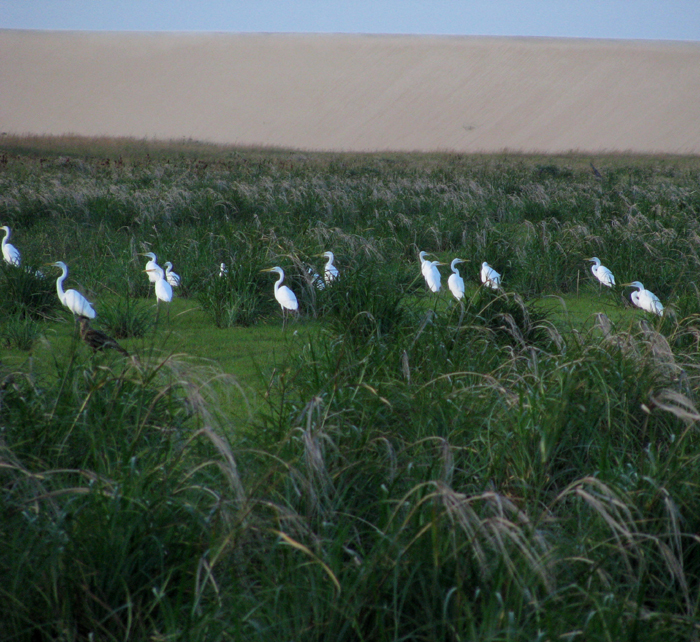
|

